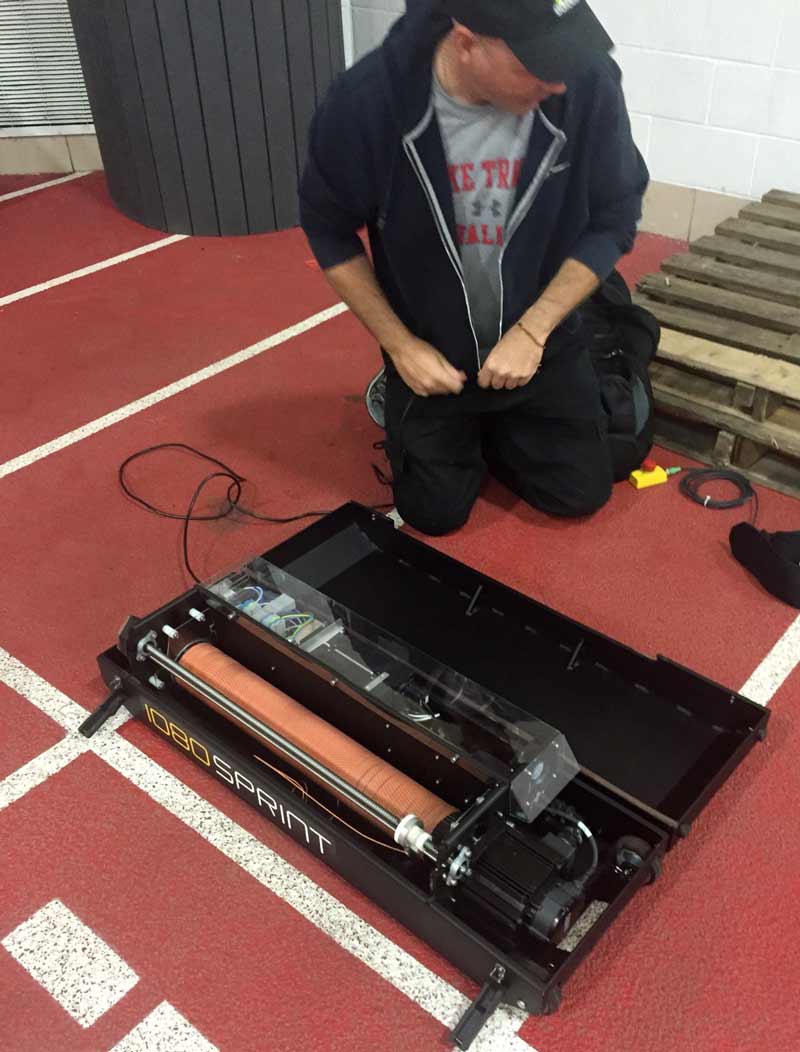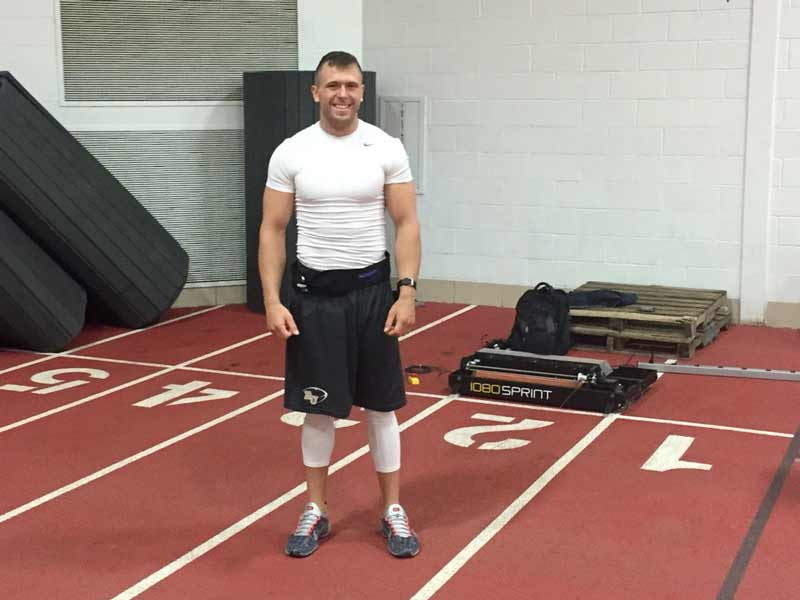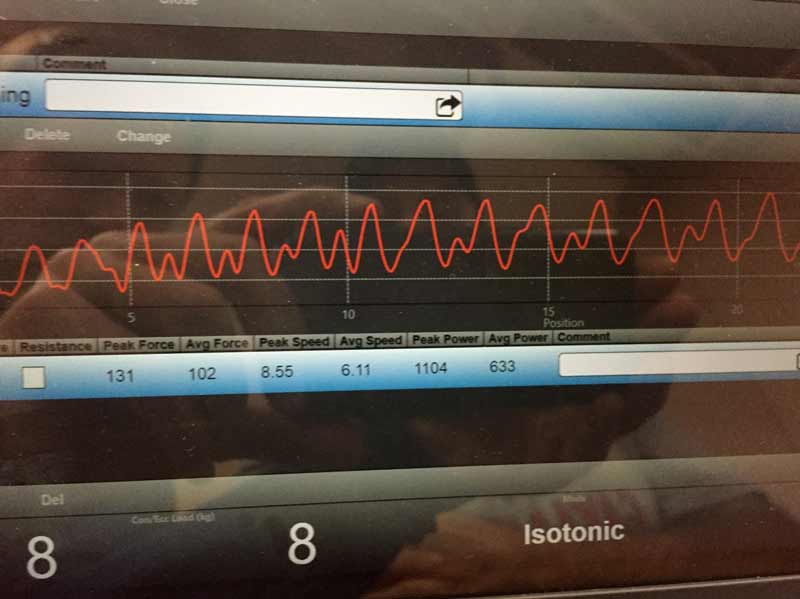
Editor’s Note: Chris Korfist will be teaching these and other speed training techniques at the Speed Activation Consotium in Lombard, Illinois on June 19 and 20. Other presenters at the consortium include Tony Holler, Cal Dietz, Jeol Smith, Dr. Kerry Egan, Dr. Tom Nelson, Dr. Kerry Heitkotter, Dr. Eric Janota, and Dan Fichter. Make your reservations today here.
Like many of you, I surf the internet, looking for the magic bullet to solve all my problems. I like toys. If there is anything that may get me one step closer to my Holy Grail quest of making someone run really fast, I am all over it.
Unfortunately, I have wasted a ton of money on stuff that doesn’t work and now takes up storage space. Some of it I modify, so it is useful to me at least in a small way. One piece became an expensive podium/table. Another now serves simply as just flooring so we can get good traction when we start, and as a spacer to make the cable on the Run Rocket the right length.
But I never give up. When something piques my interest, I’ll call or email. In some cases I strike gold. I love my kBox and GymAware.
The 1080 Sprint looked cool when I came across it online about six weeks ago. A speed assessor and adjuster is the best way to describe it. A box contains a very thin but strong cord wrapped around a carbon-fiber drum. The computer connected to the box monitors and controls the resistance or towing strength of the cord through an electric motor. The computer also records the force and speed applied to the cord as the athlete runs and records it on the screen.

Figure 1: 1080 Sprint with top open to reveal cable mechanism.
At its lowest setting, the athlete tows 1kg of resistance, with 15kg the highest. It will also tow up to 15kg (for overspeed training we worked at 3kg). You can move in multiple directions as well. Future software updates will measure contact and flight time, resulting in a stiffness measurement.
When I called, the quoted price was too high (I am getting ready to pay for my daughter’s braces). But they said they were in the area and wanted my opinion on the machine, adding that the demo would only take 30 minutes. So Peter showed up at my door early on a Sunday several weeks later. I was in a bad mood because my 4×200 relay had been disqualified in the state meet the day before. We were sitting in a distant second place. My 4th runner got excited and left early. And it was 48 degrees and raining this morning.
Along with one of my veteran athletes who is currently with an NFL team, we went to a fieldhouse and easily unloaded a suitcase-shaped box. The top popped open, we plugged it in, and it was ready to go. My guy put on the belt Peter gave him and ran a 40. So far, nothing major.

Figure 2: NFL athlete prepares for the workout. Note the 1080 Sprint is approximately width of a track lane.
Then I looked at Peter’s laptop. I saw a power graph measured in watts for every step my guy took. Peter hit a tab, and it changed to m/s. Peter mentioned that the graph showed that one of my athlete’s legs had a lower peak than the other. I thought, well, that is easy to fix. I activated him. He ran again. Not only did the activation bring the leg back to even, it raised his power output by 10%! I had just quantified all the activation stuff I have been using for the last 4 years in three minutes. No more bad mood!
It got even more interesting. We looked at my athlete’s profile and started to manipulate where we would add more resistance to different parts of his 40. I thought, crank it at the beginning and decrease over time. My guy said it felt great and made him feel really explosive after the run.
Then we manipulated other parts of his 40. He commented on how smooth the whole thing felt. Except for the belt, he never felt pulled/jerked. And the whole time, we could change the resistance with a keystroke. I thought, how great is this for acceleration work. I could figure exactly where to apply resistance.

Figure 3: 1080 Sprint App displays performance for immediate feedback and analysis.
A sled, especially a light sled, bounces from side to side. And there’s always the cringe moment when you think the sled is going to hit the athlete in the back of the legs. Then there’s the friction between the sled and the ground. Every sled feels different on different surfaces or at various temperatures. Those days are gone. Now I know exactly how hard my athlete is pulling, and can change it at any time.
Peter said it had an over-speed function as well. I have never been a fan. It may due to the fact that it is incredibly difficult to quantify the 3%. Or perhaps from my high school experience of stretching my over-speed bungee too far from the goal post. The strap broke, with me facing the wrath of 30m of rubber cord hurtling at the poor sap it was strapped to.
Despite my reservations, I had to try it. My athlete pulled out the cord to the length of the fieldhouse. His top speed was 9.51 m/s. We adjusted the cylinder to pull him at 9.8 m/s and gave him a 20m fly-in before the 1080 started its towing function. Sure enough, that was the exact speed he ran without one heel strike/braking mechanism kicking in. Now I could train acceleration and top-end speed with pinpoint accuracy.
I started visiting force/velocity curves and power equations in my head (realizing I should have paid more attention in school). I must not have paid attention when Peter said, “Now we will work on agility.” Next thing I knew, my athlete was running out routes. Based on the graph, we could measure and assist or resist different parts of his route. We did a pro agility test that put added pressure on his cuts, so he had to absorb more force than he normally does (a plyometric in agility?!?!). And he could do it in both directions! Using the software, an athlete’s eccentric to concentric rate of force can be determined.
Video 1. The 1080 Sprint can be used for resistance sprinting, over-speed sprinting, and change of direction drills.
The 30 minutes turned into three hours. I was late for my first training session. Peter tagged along and gave workouts to my next two groups. It blew them away. A pro basketball player couldn’t stop thinking of all of its applications for training with agility and shooting. My brain was swimming with all the potential applications. That is how Peter left me.
And my daughter? She’ll just have to deal with crooked teeth.
Please share this article so others may benefit.
The post 1080 Sprint Review appeared first on Freelap USA.